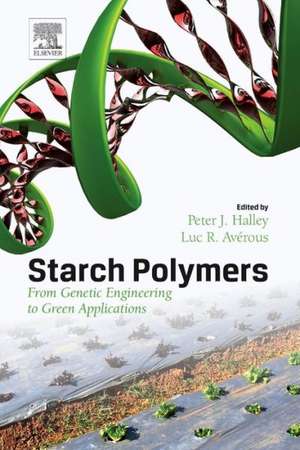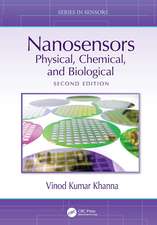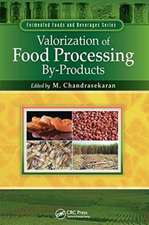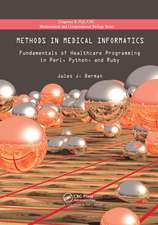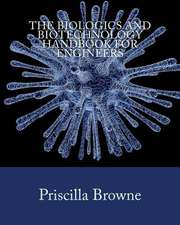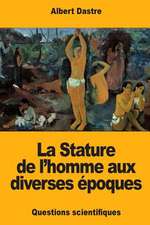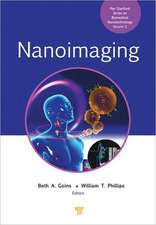Starch Polymers: From Genetic Engineering to Green Applications
Editat de P. Halley, L. Averousen Limba Engleză Hardback – 17 noi 2014
- Focuses on cutting edge applications of starch polymers, including starch genetics and Rheology
- Contains working examples and provides real problems and solutions in the area of biomaterials, nanomaterials, and renewable materials
- Provides systematic and in-depth coverage and critical assessment of all starch properties and applications from top scientists in the industry
Preț: 1216.96 lei
Preț vechi: 1667.07 lei
-27% Nou
Puncte Express: 1825
Preț estimativ în valută:
232.94€ • 253.11$ • 195.80£
232.94€ • 253.11$ • 195.80£
Carte tipărită la comandă
Livrare economică 22 aprilie-06 mai
Preluare comenzi: 021 569.72.76
Specificații
ISBN-13: 9780444537300
ISBN-10: 0444537309
Pagini: 484
Ilustrații: Approx. 100 illustrations
Dimensiuni: 152 x 229 x 28 mm
Greutate: 0.91 kg
Editura: ELSEVIER SCIENCE
ISBN-10: 0444537309
Pagini: 484
Ilustrații: Approx. 100 illustrations
Dimensiuni: 152 x 229 x 28 mm
Greutate: 0.91 kg
Editura: ELSEVIER SCIENCE
Public țintă
Graduate and postgraduate research students and industrial researchers in the areas of Organic Chemistry, Physical Chemistry, Applied Chemistry, Food Science/Chemistry; Biochemistry; Biotechnology/ bioengineering Biomedical Engineering and Chemical Engineering; agricultural chemists, researchers in related industries such as paper, textiles, adhesives, plastics, biomaterials, biofuels, renewable energy, nanomaterials, food industry, packaging and polymer industry.Cuprins
1. INTRODUCTION
1.1. Starch polymers – from the field to industrial products (Peter Halley, and Luc Averous)
2. STARCH GENETICS
2.1. Genetically modified starch: state of art and perspectives (Matthew Morell)
2.2. Structure-properties relationships for genetically modified starch (Peter Halley, and Ihwa Tan)
3. NOVEL STARCH MODIFIED BY BIOTECHNOLOGY
3.1. Starch modification by biotechnology: state of art and perspectives (Richard G.F. Visser, and Luisa Trindade)
3.2. The application of enzymes involved in starch derivatization: recent developments (Carmen Boeriu)
4. NOVEL STARCH MODIFIED BY CHEMISTRY
4.1. Chemically modified Starch to develop novel materials: state of art and perspectives (Ken Mcnaught)
4.2.Starch modification (Atanu Biswas, and J.L.Willett)
5. STRUCTURES AND PROPERTIES OF NOVEL STARCH-BASED MATERIALS
5.1. Structure-Properties of starch-based blends and micro/nanocomposites: state of art and perspectives (Rowan Truss, Celine Chaleat, and Peter Halley)
5.2. Nano-biocomposites based on plasticized starch: state of art and perspectives (Luc Averous, and Eric Pollet)
5.3. Processing and long term properties of starch polymers and blends (Fengwei Xie, Rowan Truss, Peter Halley, and Celine Chaleat)
6.NOVEL CHARACTERISATION METHODS
6.1. Characterization methods for starch-based materials: state of art and perspectives (Robert Gilbert)
6.2.Starch NMR (Mike Gidley)
7. NOVEL PROCESSING
7.1. Processing of plasticized starch-based materials: state of art and perspectives (Long Yu, Fengwei Xie, and Peng Liu)
7.2. Reactive extrusion for thermoplastic starch polymer blends (Peter Halley, and Raju Maliger)
8. DEGRADATION AND BIODEGRADATION
8.1. Degradation and biodegradation standards for starch-based materials (Joe Greene)
8.2. Effect of the formulation, structure and processing on biodegradation (Katherine Dean)
9. APPLICATIONS
9.1. Starch applications: state of market and new trends (Peter Halley, and Bronwyn Laycock)
9.2. Starch plastics packaging and agricultural applications (Greg Glenn, Syed H. Imam, William J. Orts, and Bor-Sen Chiou)
9.3. Water resistant thermoplastics starch polymer applications (Ann Roberts, Nick Mccaffrey, and Celine Chaleat)
1.1. Starch polymers – from the field to industrial products (Peter Halley, and Luc Averous)
2. STARCH GENETICS
2.1. Genetically modified starch: state of art and perspectives (Matthew Morell)
2.2. Structure-properties relationships for genetically modified starch (Peter Halley, and Ihwa Tan)
3. NOVEL STARCH MODIFIED BY BIOTECHNOLOGY
3.1. Starch modification by biotechnology: state of art and perspectives (Richard G.F. Visser, and Luisa Trindade)
3.2. The application of enzymes involved in starch derivatization: recent developments (Carmen Boeriu)
4. NOVEL STARCH MODIFIED BY CHEMISTRY
4.1. Chemically modified Starch to develop novel materials: state of art and perspectives (Ken Mcnaught)
4.2.Starch modification (Atanu Biswas, and J.L.Willett)
5. STRUCTURES AND PROPERTIES OF NOVEL STARCH-BASED MATERIALS
5.1. Structure-Properties of starch-based blends and micro/nanocomposites: state of art and perspectives (Rowan Truss, Celine Chaleat, and Peter Halley)
5.2. Nano-biocomposites based on plasticized starch: state of art and perspectives (Luc Averous, and Eric Pollet)
5.3. Processing and long term properties of starch polymers and blends (Fengwei Xie, Rowan Truss, Peter Halley, and Celine Chaleat)
6.NOVEL CHARACTERISATION METHODS
6.1. Characterization methods for starch-based materials: state of art and perspectives (Robert Gilbert)
6.2.Starch NMR (Mike Gidley)
7. NOVEL PROCESSING
7.1. Processing of plasticized starch-based materials: state of art and perspectives (Long Yu, Fengwei Xie, and Peng Liu)
7.2. Reactive extrusion for thermoplastic starch polymer blends (Peter Halley, and Raju Maliger)
8. DEGRADATION AND BIODEGRADATION
8.1. Degradation and biodegradation standards for starch-based materials (Joe Greene)
8.2. Effect of the formulation, structure and processing on biodegradation (Katherine Dean)
9. APPLICATIONS
9.1. Starch applications: state of market and new trends (Peter Halley, and Bronwyn Laycock)
9.2. Starch plastics packaging and agricultural applications (Greg Glenn, Syed H. Imam, William J. Orts, and Bor-Sen Chiou)
9.3. Water resistant thermoplastics starch polymer applications (Ann Roberts, Nick Mccaffrey, and Celine Chaleat)
